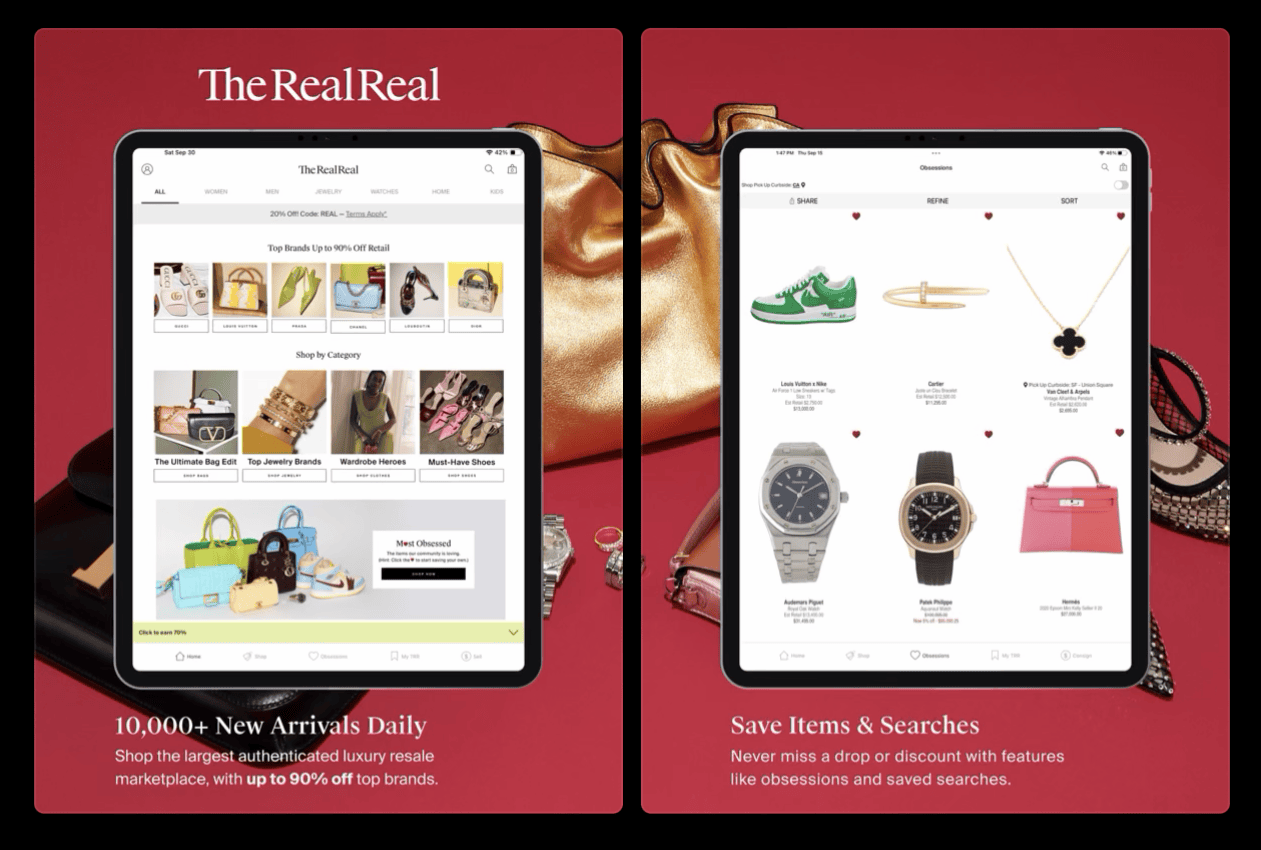Shopping
7 Ways Luxury Shopping Apps are Adapting to Consumer Trends

Excellence in Apps: 7 Ways Luxury Shopping Apps are Adapting to Consumer Trends
By Mackenzie Richard and Anne McCarthy
What creates an excellent shopping app experience? This is an essential question for retailers to consider, especially as Forbes reports that the global e-commerce market is projected to total over $6 trillion this year. Shopping apps allow retailers to reach a global audience, not just a local one.
The Impression sat down with key retailers leading the way in excellence in shopping apps to understand their vision for the future and some key strategies. Among these leaders are Net-A-Porter and The Real Real, both renowned for their innovative approaches to online luxury retail. These companies not only shape trends but also deeply understand the needs and preferences of their discerning clients.
In the rapidly evolving landscape of luxury retail, mobile applications like the Harrods app are redefining how brands engage and retain customers. As consumer preferences pivot towards online shopping, these platforms are challenged to offer more than just products—they must deliver memorable experiences that resonate deeply with their users.
The challenge for luxury shopping apps is not just attracting customers but retaining them in a rapidly evolving market. This scenario is unfolding against a backdrop of mixed consumer confidence across regions where geopolitical concerns and price increases are influencing shopping behaviors. With these market dynamics in play, luxury shopping apps must navigate a landscape where consumers increasingly seek a seamless blend of online and offline shopping experiences.
Retailers are constantly innovating and aiming to keep customers—loyal and new—engaged within a digital landscape where there’s much competition for a shopper’s attention. The competition is fierce not only among retailers but also with other apps, especially social media, vying for the same precious screen time on users’ devices. Capturing a shopper’s attention in such a cluttered space requires innovative strategies to stand out. Offering exclusive promotions, sneak peeks of new products, or unique app-only experiences can entice users to install the app. Additionally, leveraging social media influencers to showcase the ease of use and unique features of the app can create a buzz, encouraging their followers to download and try the app themselves.
Retention of customers is an important piece of the puzzle, with a focus not only on drawing customers in but also on creating a compelling enough value proposition to keep them engaged over time.
As luxury brands navigate the blend of online and offline realms, their success will increasingly depend on how well they adapt to and integrate these innovative strategies. This article explores how top luxury shopping apps are not just facing up to the challenges of the digital era but are turning these challenges into opportunities for growth and enhanced customer loyalty.
Focusing on High Customer Retention through Innovative Strategies

Luxury apps, like the Harrods app, pivot and innovate to maintain customer interest. The key lies in understanding changing consumer preferences. With a shift towards online shopping, these platforms need to offer more than just products; they must provide a memorable experience.
Personalization, exclusive offers, and seamless user interfaces are becoming essential features for keeping the modern luxury shopper engaged. Loyalty programs and “points” systems are another feature that make shoppers feel like part of the company family. The RealReal, with its focus on luxury consignment, offers a unique model that keeps consumers engaged through a constantly refreshing inventory. Their approach combines the thrill of discovery with the assurance of authenticity and sustainability, which are increasingly important to today’s luxury shoppers.
Meanwhile, NET-A-PORTER and MR PORTER tell The Impression that they “utilize unique data for a greater understanding of our users and their values.” Online engagement is a driver for the company but they note that “offline connection is also essential.”
For luxury brands, a robust digital strategy is a necessity. This strategy encompasses a strong mobile presence, an expert use of social media, and a focus on the metrics that truly matter: customer engagement and retention. It’s about creating an online persona that resonates with the brand’s exclusive image while maintaining a feeling of accessibility and engagement for the digital consumer.
Creating an “Omnichannel Experience” & Localized Experiences
European luxury brands elevate the customer experience by focusing on omnichannel behavior. The “omnichannel experience” means consumers are blending in-store and online shopping experiences. Brands offering a cohesive, seamless experience across different channels are more likely to succeed. This trend underlines the importance of integrating physical and digital retail strategies to meet the evolving demands of consumers.
NET-A-PORTER focuses on localization, tailoring experiences to individual regions and ensuring relevance in diverse markets. This strategy acknowledges and caters to a global customer base’s varying needs and preferences.


As the line between online and offline continues to blur, luxury brands need to ensure that their digital strategies complement their in-store experiences, creating a holistic brand journey for the customer.
Successfully Overcoming E-commerce Challenges
The transition to online hasn’t been smooth for all. Luxury e-commerce platforms have faced challenges, including fluctuating demand and financial losses. However, some have turned these challenges into opportunities by enhancing customer engagement through technology and refining their business models to be more adaptable and resilient.
For instance, The RealReal’s model capitalizes on the growing trend of sustainability in fashion, offering a platform for buying and selling authenticated pre-owned luxury goods. This not only addresses consumer demand for environmentally conscious options, but also creates a unique market niche that helps mitigate some of the common challenges faced by other e-commerce luxury retailers.


Leveraging AI: Personal Shopping & Data-Driven Insights
Innovations like LetsBab and EditorialistYX illustrate the power of personalized shopping experiences. These platforms are leveraging technology to recreate the intimacy and customization of in-store shopping online. Moreover, the integration of AI, as seen with Hewi, is transforming how customers interact with luxury shopping apps. AI-driven chatbots and personalized recommendations are making the shopping experience more efficient and enjoyable.
Both NET-A-PORTER and The RealReal, for instance, use customer data to personalize the shopping experience. NET-A-PORTER aims for over 5.3 million different homepages, each tailored to individual customer profiles. This level of personalization, driven by data insights, ensures that each user’s experience is unique and aligned with their preferences, enhancing customer satisfaction and loyalty.
Innovations in personalized shopping experiences and AI are evident across platforms. The RealReal utilizes data and technology to curate and recommend products, enhancing the shopping experience. Their focus on providing detailed product information and history adds a layer of personalization and trust, essential for luxury consumers seeking authenticity in pre-owned items.






Focusing on Overall Digital Strategy
For luxury brands, a robust digital strategy is no longer a luxury but a necessity. This strategy encompasses a strong mobile presence, judicious use of social media, and a focus on metrics that truly matter – customer engagement and retention.
The RealReal’s effective use of digital storytelling and social media engagement highlights the importance of an online persona that resonates with the brand’s exclusive image while being accessible and engaging to the digital consumer.
Orr Shakked, Chief Marketing Officer at The RealReal tells The Impression, “Our social channels, specifically Instagram and TikTok, are used to help us tell stories, share the latest trends and understand what our customers are looking for.” Shakked shares how The RealReal specifically highlights articles and facts about the environmental power of resale. “We amplify the stories of real people from our community,” he adds.
Offering High-Quality Customer Service & High-Value Loyalty Programs
Shakked explains there’s one key factor that will dictate a company’s success. “The most critical piece that makes any company successful is its commitment to customers,” he says. This is why The RealReal prioritizes offering an “unparalleled, luxury experience” to its customers, making them “feel supported and knowledgeable.” Shakked explains how The RealReal offers a dedicated concierge team to support sellers through each step of the process.
NET-A-PORTER highlights its white-glove service, especially for EIPs (Extremely Important Person). Their Personal Shopping team offers round-the-clock assistance, including style advice and access to coveted fashion items. This level of customer service not only meets––but often exceeds––the high standards expected by luxury shoppers. NET-A-PORTER tells The Impression, “we also offer our EIPs invitations to money-can’t-buy experiences and global events with our brand partners.”
NET-A-PORTER’s loyalty program includes exclusive benefits like tiered reward systems, complimentary premium delivery, and early access to new launches. This approach fosters a sense of exclusivity and privilege among customers, encouraging continued engagement and spending.
Integration with Editorial Content
Both NET-A-PORTER and The RealReal integrate their offerings with compelling editorial content. For instance, NET-A-PORTER’s PORTER magazine serves as a hub for fashion, shopping, and trend reports, which reflects in their app and social media content. This integration provides an enriched, engaging experience that goes beyond traditional shopping, involving customers in a wider fashion and lifestyle narrative.
NET-A-PORTER, which has an online audience of over nine million, tells The Impression, “[we] produce original daily content that inspires and informs our global community through immersive storytelling and showcasing stylish and inspiring men, places, and products.” The publication features mega-stars like Samuel L. Jackson and publishes regular content that also raises awareness for men’s mental and physical health.
The post-pandemic era presents both challenges and opportunities for luxury shopping apps. By focusing on customer retention through innovative digital strategies, enhancing the omnichannel experience, overcoming e-commerce hurdles, leveraging AI and personalization, staying ahead of future trends, and more, these platforms can not only survive but thrive.
The luxury shopping experience is being redefined, and those who can navigate this shift effectively will lead the way in the new digital frontier of high fashion.







:max_bytes(150000):strip_icc()/roundup-writereditor-loved-deals-tout-f5de51f85de145b2b1eb99cdb7b6cb84.jpg)


